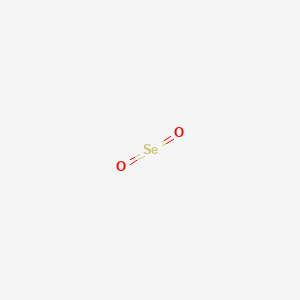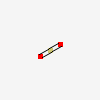Selenium Oxides
- SELENIUM DIOXIDE
- Selenium(IV) oxide
- 7446-08-4
- Selenium oxide
- Selenious anhydride
- Create:2005-03-26
- Modify:2025-01-11

13814-59-0 (cadmium[1:1] salt)
15702-34-8 (manganese(+2)[1:1] salt)
- Dioxide, Selenium
- Monoxide, Selenium
- Oxide, Selenium
- Oxides, Selenium
- selenium dioxide
- Selenium Monoxide
- selenium oxide
- Selenium Oxides
- selenium trioxide
- Trioxide, Selenium
- SELENIUM DIOXIDE
- Selenium(IV) oxide
- 7446-08-4
- Selenium oxide
- Selenious anhydride
- Oxoselane oxide
- Selenium dioxide dimer
- Selenous acid anhydride
- Selenium oxide (SeO2)
- Selenium(IV) dioxide (1:2)
- Selenium oxide (Se2O4)
- RCRA waste number U204
- Selenium oxide (1:2)
- CCRIS 5820
- HSDB 677
- 9N3UK29E57
- EINECS 231-194-7
- MFCD00003562
- NSC 56753
- NSC-56753
- SELENIUM (IV) OXIDE
- SELENIUM DIOXIDE [HSDB]
- 12640-89-0
- DTXSID4021264
- Seleniumdioxide
- EC 231-194-7
- Selenous anhydride
- Selenium(IV) dioxide
- Selenonyl
- seleninyl oxygen
- dioxido de selenio
- Oxoselane oxide #
- biossido di selenio
- dioxyde de selenium
- EINECS 235-738-4
- SeO2
- Selenium oxide, SeO2
- selenium (IV) dioxide
- SELENIUM OXIDE [MI]
- WLN: SE O2
- UNII-9N3UK29E57
- DTXCID901264
- CHEMBL3183452
- SELENIUM OXIDE [WHO-DD]
- (oxo-lambda4-selanylidene)oxidane
- Selenium dioxide, puriss., 98%
- NSC56753
- Tox21_202597
- NA2811
- STL264213
- AKOS015855284
- Selenium oxide [NA2811] [Poison]
- Selenium(IV) oxide (99.999%-Se)
- NCGC00260145-01
- BP-21360
- CAS-7446-08-4
- DB-004088
- E1459
- NS00113742
- Selenium dioxide, reagent grade, powder, 98%
- Selenium dioxide, >=99.9% trace metals basis
- Selenium dioxide, 99.999% trace metals basis
- A838139
- Q411386
- Selenium dioxide, ReagentPlus(R), powder, 99.8% trace metals basis
Photographic Processing [Category: Other]
Glass Manufacturing [Category: Industry]




H301 (100%): Toxic if swallowed [Danger Acute toxicity, oral]
H314 (10.2%): Causes severe skin burns and eye damage [Danger Skin corrosion/irritation]
H318 (10.2%): Causes serious eye damage [Danger Serious eye damage/eye irritation]
H331 (89.8%): Toxic if inhaled [Danger Acute toxicity, inhalation]
H373 (100%): May causes damage to organs through prolonged or repeated exposure [Warning Specific target organ toxicity, repeated exposure]
H400 (52.3%): Very toxic to aquatic life [Warning Hazardous to the aquatic environment, acute hazard]
H410 (100%): Very toxic to aquatic life with long lasting effects [Warning Hazardous to the aquatic environment, long-term hazard]
P260, P261, P264, P264+P265, P270, P271, P273, P280, P301+P316, P301+P330+P331, P302+P361+P354, P304+P340, P305+P354+P338, P316, P317, P319, P321, P330, P363, P391, P403+P233, P405, and P501
(The corresponding statement to each P-code can be found at the GHS Classification page.)
Aggregated GHS information provided per 264 reports by companies from 21 notifications to the ECHA C&L Inventory. Each notification may be associated with multiple companies.
Information may vary between notifications depending on impurities, additives, and other factors. The percentage value in parenthesis indicates the notified classification ratio from companies that provide hazard codes. Only hazard codes with percentage values above 10% are shown.
Acute Tox. 3 (100%)
Skin Corr. 1B (10.2%)
Eye Dam. 1 (10.2%)
Acute Tox. 3 (89.8%)
STOT RE 2 (100%)
Aquatic Acute 1 (52.3%)
Aquatic Chronic 1 (100%)
Acute toxicity (Oral) - Category 2
Serious eye damage/eye irritation - Category 2A-2B
Specific target organ toxicity - Single exposure - Category 1 (heart, central nervous system, blood system), Category 2 (respiratory system)
Specific target organ toxicity - Repeated exposure - Category 1 (respiratory system, liver), Category 2 (kidney)
Hazardous to the aquatic environment (Acute) - Category 1
Hazardous to the aquatic environment (Long-term) - Category 1
Consult physician after all exposures to this compound.
INHALATION: remove victim to fresh air; give oxygen if needed.
INGESTION: induce vomiting; follow with gastric lavage and saline cathartics.
EYES: flush immediately and thoroughly with water.
SKIN: flush with water. (USCG, 1999)
Excerpt from ERG Guide 151 [Substances - Toxic (Non-Combustible)]:
SMALL FIRE: Dry chemical, CO2 or water spray.
LARGE FIRE: Water spray, fog or regular foam. If it can be done safely, move undamaged containers away from the area around the fire. Dike runoff from fire control for later disposal. Avoid aiming straight or solid streams directly onto the product.
FIRE INVOLVING TANKS, RAIL TANK CARS OR HIGHWAY TANKS: Fight fire from maximum distance or use unmanned master stream devices or monitor nozzles. Do not get water inside containers. Cool containers with flooding quantities of water until well after fire is out. Withdraw immediately in case of rising sound from venting safety devices or discoloration of tank. ALWAYS stay away from tanks in direct contact with flames. For massive fire, use unmanned master stream devices or monitor nozzles; if this is impossible, withdraw from area and let fire burn. (ERG, 2024)
Excerpt from ERG Guide 151 [Substances - Toxic (Non-Combustible)]:
IMMEDIATE PRECAUTIONARY MEASURE: Isolate spill or leak area in all directions for at least 50 meters (150 feet) for liquids and at least 25 meters (75 feet) for solids.
SPILL: Increase the immediate precautionary measure distance, in the downwind direction, as necessary.
FIRE: If tank, rail tank car or highway tank is involved in a fire, ISOLATE for 800 meters (1/2 mile) in all directions; also, consider initial evacuation for 800 meters (1/2 mile) in all directions. (ERG, 2024)
Excerpt from ERG Guide 151 [Substances - Toxic (Non-Combustible)]:
Do not touch damaged containers or spilled material unless wearing appropriate protective clothing. Stop leak if you can do it without risk. Prevent entry into waterways, sewers, basements or confined areas. Cover with plastic sheet to prevent spreading. Absorb or cover with dry earth, sand or other non-combustible material and transfer to containers. DO NOT GET WATER INSIDE CONTAINERS. For solids, prevent dust cloud and avoid inhalation of dust. (ERG, 2024)
Neurotoxin - Other CNS neurotoxin
Occupational hepatotoxin - Secondary hepatotoxins: the potential for toxic effect in the occupational setting is based on cases of poisoning by human ingestion or animal experimentation.
Reproductive Toxin - A chemical that is toxic to the reproductive system, including defects in the progeny and injury to male or female reproductive function. Reproductive toxicity includes developmental effects. See Guidelines for Reproductive Toxicity Risk Assessment.
Dermatotoxin - Skin burns.
Skin Sensitizer - An agent that can induce an allergic reaction in the skin.
Toxic Pneumonitis - Inflammation of the lungs induced by inhalation of metal fumes or toxic gases and vapors.
Patents are available for this chemical structure:
https://patentscope.wipo.int/search/en/result.jsf?inchikey=JPJALAQPGMAKDF-UHFFFAOYSA-N
- Australian Industrial Chemicals Introduction Scheme (AICIS)Selenium oxide (SeO2)https://services.industrialchemicals.gov.au/search-inventory/
- CAMEO ChemicalsLICENSECAMEO Chemicals and all other CAMEO products are available at no charge to those organizations and individuals (recipients) responsible for the safe handling of chemicals. However, some of the chemical data itself is subject to the copyright restrictions of the companies or organizations that provided the data.https://cameochemicals.noaa.gov/help/reference/terms_and_conditions.htm?d_f=falseSELENIUM DIOXIDEhttps://cameochemicals.noaa.gov/chemical/9042CAMEO Chemical Reactivity Classificationhttps://cameochemicals.noaa.gov/browse/react
- ILO-WHO International Chemical Safety Cards (ICSCs)
- CAS Common ChemistryLICENSEThe data from CAS Common Chemistry is provided under a CC-BY-NC 4.0 license, unless otherwise stated.https://creativecommons.org/licenses/by-nc/4.0/Selenium dioxidehttps://commonchemistry.cas.org/detail?cas_rn=7446-08-4
- ChemIDplusChemIDplus Chemical Information Classificationhttps://pubchem.ncbi.nlm.nih.gov/source/ChemIDplus
- DTP/NCILICENSEUnless otherwise indicated, all text within NCI products is free of copyright and may be reused without our permission. Credit the National Cancer Institute as the source.https://www.cancer.gov/policies/copyright-reuse
- EPA Chemicals under the TSCASelenium oxide (SeO2)https://www.epa.gov/chemicals-under-tscaEPA TSCA Classificationhttps://www.epa.gov/tsca-inventory
- European Chemicals Agency (ECHA)LICENSEUse of the information, documents and data from the ECHA website is subject to the terms and conditions of this Legal Notice, and subject to other binding limitations provided for under applicable law, the information, documents and data made available on the ECHA website may be reproduced, distributed and/or used, totally or in part, for non-commercial purposes provided that ECHA is acknowledged as the source: "Source: European Chemicals Agency, http://echa.europa.eu/". Such acknowledgement must be included in each copy of the material. ECHA permits and encourages organisations and individuals to create links to the ECHA website under the following cumulative conditions: Links can only be made to webpages that provide a link to the Legal Notice page.https://echa.europa.eu/web/guest/legal-noticeSelenium dioxidehttps://chem.echa.europa.eu/100.028.358Selenium dioxide (EC: 231-194-7)https://echa.europa.eu/information-on-chemicals/cl-inventory-database/-/discli/details/116148
- FDA Global Substance Registration System (GSRS)LICENSEUnless otherwise noted, the contents of the FDA website (www.fda.gov), both text and graphics, are not copyrighted. They are in the public domain and may be republished, reprinted and otherwise used freely by anyone without the need to obtain permission from FDA. Credit to the U.S. Food and Drug Administration as the source is appreciated but not required.https://www.fda.gov/about-fda/about-website/website-policies#linkingSELENIUM DIOXIDEhttps://gsrs.ncats.nih.gov/ginas/app/beta/substances/9N3UK29E57
- Hazardous Substances Data Bank (HSDB)SELENIUM DIOXIDEhttps://pubchem.ncbi.nlm.nih.gov/source/hsdb/677
- New Zealand Environmental Protection Authority (EPA)LICENSEThis work is licensed under the Creative Commons Attribution-ShareAlike 4.0 International licence.https://www.epa.govt.nz/about-this-site/general-copyright-statement/
- NJDOH RTK Hazardous Substance Listselenium oxidehttp://nj.gov/health/eoh/rtkweb/documents/fs/1651.pdf
- Haz-Map, Information on Hazardous Chemicals and Occupational DiseasesLICENSECopyright (c) 2022 Haz-Map(R). All rights reserved. Unless otherwise indicated, all materials from Haz-Map are copyrighted by Haz-Map(R). No part of these materials, either text or image may be used for any purpose other than for personal use. Therefore, reproduction, modification, storage in a retrieval system or retransmission, in any form or by any means, electronic, mechanical or otherwise, for reasons other than personal use, is strictly prohibited without prior written permission.https://haz-map.com/AboutSelenium dioxidehttps://haz-map.com/Agents/2198
- Toxin and Toxin Target Database (T3DB)LICENSET3DB is offered to the public as a freely available resource. Use and re-distribution of the data, in whole or in part, for commercial purposes requires explicit permission of the authors and explicit acknowledgment of the source material (T3DB) and the original publication.http://www.t3db.ca/downloadsSelenium dioxidehttp://www.t3db.ca/toxins/T3D1819
- ChEMBLLICENSEAccess to the web interface of ChEMBL is made under the EBI's Terms of Use (http://www.ebi.ac.uk/Information/termsofuse.html). The ChEMBL data is made available on a Creative Commons Attribution-Share Alike 3.0 Unported License (http://creativecommons.org/licenses/by-sa/3.0/).http://www.ebi.ac.uk/Information/termsofuse.html
- NITE-CMCSelenium dioxide - FY2006 (New/original classication)https://www.chem-info.nite.go.jp/chem/english/ghs/06-imcg-0282e.htmlSelenium dioxide - FY2014 (Revised classification)https://www.chem-info.nite.go.jp/chem/english/ghs/14-mhlw-2055e.html
- Japan Chemical Substance Dictionary (Nikkaji)
- NIST Mass Spectrometry Data CenterLICENSEData covered by the Standard Reference Data Act of 1968 as amended.https://www.nist.gov/srd/public-lawSelenium(IV) oxidehttp://www.nist.gov/srd/nist1a.cfm
- SpectraBaseSELENIUM OXIDE (SEO2)https://spectrabase.com/spectrum/33xoIz5I9frSelenium(IV) oxidehttps://spectrabase.com/spectrum/EwCVGFxfTF7SELENIUM OXIDEhttps://spectrabase.com/spectrum/Cb8RP8BbEqaSELENIUM DIOXIDEhttps://spectrabase.com/spectrum/5zRFfJuwKdSSELENIUM DIOXIDEhttps://spectrabase.com/spectrum/3amZMyxPJQY
- Springer Nature
- Thieme ChemistryLICENSEThe Thieme Chemistry contribution within PubChem is provided under a CC-BY-NC-ND 4.0 license, unless otherwise stated.https://creativecommons.org/licenses/by-nc-nd/4.0/
- Wikidataselenium dioxidehttps://www.wikidata.org/wiki/Q411386
- Wikipediaselenium(IV) oxidehttps://en.wikipedia.org/wiki/Selenium(IV)_oxideSelenium dioxidehttps://en.wikipedia.org/wiki/Selenium_dioxide
- Wiley
- Medical Subject Headings (MeSH)LICENSEWorks produced by the U.S. government are not subject to copyright protection in the United States. Any such works found on National Library of Medicine (NLM) Web sites may be freely used or reproduced without permission in the U.S.https://www.nlm.nih.gov/copyright.htmlSelenium Oxideshttps://www.ncbi.nlm.nih.gov/mesh/68064588
- PubChem
- GHS Classification (UNECE)GHS Classification Treehttp://www.unece.org/trans/danger/publi/ghs/ghs_welcome_e.html
- NORMAN Suspect List ExchangeLICENSEData: CC-BY 4.0; Code (hosted by ECI, LCSB): Artistic-2.0https://creativecommons.org/licenses/by/4.0/NORMAN Suspect List Exchange Classificationhttps://www.norman-network.com/nds/SLE/
- EPA Substance Registry ServicesEPA SRS List Classificationhttps://sor.epa.gov/sor_internet/registry/substreg/LandingPage.do
- MolGenieMolGenie Organic Chemistry Ontologyhttps://github.com/MolGenie/ontology/
- PATENTSCOPE (WIPO)SID 403379820https://pubchem.ncbi.nlm.nih.gov/substance/403379820
